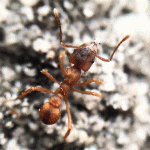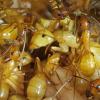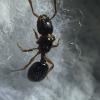- Formiculture.com
- Forums
- Gallery
- Members
- Member Map
- Chat

Trachymyrmex in NY
Started By
Flame.Hyped
, Sep 22 2017 8:08 AM
38 replies to this topic
#21
 Offline
-
Posted October 4 2017 - 2:33 PM
Offline
-
Posted October 4 2017 - 2:33 PM
Mission successful, I found multiple colonies with multiple satellite nests. Thanks for the tips
- Evanthomas89 likes this
#23
 Offline
-
Posted October 5 2017 - 9:52 AM
Offline
-
Posted October 5 2017 - 9:52 AM
I don't have any pics of the nests but I took a worker home for pics and ID, id send them if I knew how. Also I know they're satellite nests because they were very close to each other and varying in size. Cool little crescent mounds they have.
- Evanthomas89 likes this
#24
 Offline
-
Posted October 5 2017 - 10:42 AM
Offline
-
Posted October 5 2017 - 10:42 AM
I don't have any pics of the nests but I took a worker home for pics and ID, id send them if I knew how. Also I know they're satellite nests because they were very close to each other and varying in size. Cool little crescent mounds they have.
I've seen that as well but didn't see enough interaction to determine if they were satellite nests, same nest but separate entrance, or entire separate colonies.
Check out my Youtube!
#25
 Offline
-
Posted October 5 2017 - 5:39 PM
Offline
-
Posted October 5 2017 - 5:39 PM
I just assume they're satellite nests, I doubt multiple colonies would co exist very close
#26
 Offline
-
Posted October 5 2017 - 5:47 PM
Offline
-
Posted October 5 2017 - 5:47 PM
I just assume they're satellite nests, I doubt multiple colonies would co exist very close
I'm relatively new to this but I assumed a satellite nest would be like Camponotus who sometimes have completely separate nests to incubate brood and the nests can be surprisingly far from one another from what I've heard. I would assume that the nest entrances within a few feet of each other might just lead to the same nest right?
Check out my Youtube!
#27
 Offline
-
Posted October 7 2017 - 12:05 PM
Offline
-
Posted October 7 2017 - 12:05 PM
Yes if multiple nest entrance are are close together they probably all connect at some point. I think.
- Evanthomas89 likes this
#28
 Offline
-
Posted May 12 2019 - 1:40 PM
Offline
-
Posted May 12 2019 - 1:40 PM
Just stumbled upon this via a google search for Trachymyrmex ![]()
You guys have any luck with these colonies?
Evan and I had checked out the Pine Barrens in NJ back in later Oct 2017, they were quite abundant.
I wouldn't advise captivity for a hobbyist, but they are cool as heck to look at. They're mounds are crescent moon shaped, and all in the same orientation, must be they know the general wind direction and are master ventilators, as most ants are.
Anyways, let me know if you guys have had much luck finding or if you tried keeping them captive, I am curious of your findings if you did.
-Matt
#29
 Offline
-
Posted May 13 2019 - 12:15 PM
Offline
-
Posted May 13 2019 - 12:15 PM
They’re relatively easy to care for in the standard fungus grower setup of plastic boxes and a gypsum base. They accept a wide variety of organic material for their fungal substrate, some of which is extremely easy to provide. Colonies follow a rather seasonal cycle with exponential fungal growth in spring and summer. The garden can grow a little larger than a baseball. Upper colony limit is generally 400-600 workers. Brood production occurs as the fungus is grown and only a few batches of workers are produced a year. In the fall the fungus garden is gradually torn down and the ants prepare for winter estivation. While dormant the fungus garden is kept extremely small (10-15mm wide or so) and all the ants pack around it. The fungus is most sensitive at this time and sometimes does not resume growth the following year.
#30
 Offline
-
Posted May 13 2019 - 12:43 PM
Offline
-
Posted May 13 2019 - 12:43 PM
They’re relatively easy to care for in the standard fungus grower setup of plastic boxes and a gypsum base. They accept a wide variety of organic material for their fungal substrate, some of which is extremely easy to provide. Colonies follow a rather seasonal cycle with exponential fungal growth in spring and summer. The garden can grow a little larger than a baseball. Upper colony limit is generally 400-600 workers. Brood production occurs as the fungus is grown and only a few batches of workers are produced a year. In the fall the fungus garden is gradually torn down and the ants prepare for winter estivation. While dormant the fungus garden is kept extremely small (10-15mm wide or so) and all the ants pack around it. The fungus is most sensitive at this time and sometimes does not resume growth the following year.
I really shouldn't ask but is there somewhere this info is written down? Gee whoda thunk another interesting ant species! ![]()
Billy
Currently keeping:
Camponotus chromaiodes
Camponotus castaneus
Formica subsericea
#31
 Offline
-
Posted May 13 2019 - 3:11 PM
Offline
-
Posted May 13 2019 - 3:11 PM
Some good reads here. https://www.bio.fsu....schinkel#fungus
They’re relatively easy to care for in the standard fungus grower setup of plastic boxes and a gypsum base. They accept a wide variety of organic material for their fungal substrate, some of which is extremely easy to provide. Colonies follow a rather seasonal cycle with exponential fungal growth in spring and summer. The garden can grow a little larger than a baseball. Upper colony limit is generally 400-600 workers. Brood production occurs as the fungus is grown and only a few batches of workers are produced a year. In the fall the fungus garden is gradually torn down and the ants prepare for winter estivation. While dormant the fungus garden is kept extremely small (10-15mm wide or so) and all the ants pack around it. The fungus is most sensitive at this time and sometimes does not resume growth the following year.
I really shouldn't ask but is there somewhere this info is written down? Gee whoda thunk another interesting ant species!






#32
 Offline
-
Posted May 13 2019 - 4:23 PM
Offline
-
Posted May 13 2019 - 4:23 PM
You wouldn't happen to have any pictures of the setups described would you?
Colonies were housed in the laboratory under standard conditions. Each colony was housed in a tray coated with Fluon © (Northern Products, Woonsocket, RI) along the sides to prevent escapes. The ants grew their garden in a cylindrically-shaped, 175 cm3 depression in a polystyrene box lined with dental plaster. The top of this chamber was completely covered with a piece of Plexiglas. Two 9 mm diameter holes were drilled in the side of each plaster nest for the ants to enter and exit the fungus garden chamber. As colonies grew larger, additional plaster nests were added and interconnected with 5 cm segments of clean, rubber hoses. A 10 mm test tube half filled with water and plugged with cotton was placed in each tray. The plaster nest was watered weekly by filling each of four 9 mm diameter holes located in each of the four corners.
I have trouble picturing what this actually looks like.
Edited by Acutus, May 13 2019 - 7:40 PM.
Billy
Currently keeping:
Camponotus chromaiodes
Camponotus castaneus
Formica subsericea
#33
 Offline
-
Posted May 13 2019 - 7:40 PM
Offline
-
Posted May 13 2019 - 7:40 PM
In nature, incipient queens start their fungus garden by regurgitating an inoculum contained in their infrabuccal pocket ( von Ihering, 1898; Quinlan & Cherrett, 1978 ). To prevent founding failure due to inoculum loss, which commonly occurs under laboratory conditions (J. N. Seal, unpublished data), each T. septentrionalis queen was provided with 0.1 mg healthy fungus garden from a laboratory colony.
This also seems to be a bit of an obstacle, if I understand it correctly, If queens were captured and put into our typical queen test tube setups they may not be able to start the fungus on their own?
Billy
Currently keeping:
Camponotus chromaiodes
Camponotus castaneus
Formica subsericea
#34
 Offline
-
Posted May 14 2019 - 1:32 AM
Offline
-
Posted May 14 2019 - 1:32 AM
I think they need high humidity (not sure) and i'm assuming that plaster will give them a sturdier foothold and a place to put their fungus on.
#35
 Offline
-
Posted May 14 2019 - 6:07 AM
Offline
-
Posted May 14 2019 - 6:07 AM
I used plaster last year for my colonies and the fungus did great! The fungus does to be in high humidity.
#36
 Offline
-
Posted May 14 2019 - 6:09 AM
Offline
-
Posted May 14 2019 - 6:09 AM
#37
 Offline
-
Posted May 14 2019 - 11:21 AM
Offline
-
Posted May 14 2019 - 11:21 AM
I use 4x4 AMAC boxes. Hydrostone base for the garden chamber.
Thank you for the pics!
That's so cool!!! Ok so the tube in the back corner is for water to keep humidity? The ants are good with just building the fungus out in the open like that?
That makes it super cool cause I want to use it for education!
The other chamber is the out-world I assume and materials are put in there and the ants take them to the garden chamber?
This was started from a founding Queen?
Sorry for so many questions but this is just fascinating! ![]()
Edited by Acutus, May 14 2019 - 11:47 AM.
Billy
Currently keeping:
Camponotus chromaiodes
Camponotus castaneus
Formica subsericea
#38
 Offline
-
Posted May 14 2019 - 1:10 PM
Offline
-
Posted May 14 2019 - 1:10 PM
Amac boxes have very tight fitting lids, so the only access to air the garden chamber has is that which flows from the tube leading to the outworld, which keeps the humidity as high as possible. The hydrostone is watered with 2-3 milliliters every 7-10 days. I cut a 1/2”x1/2” hole in the corner of the lid for the outworld which serves as all the ventilation they need. I cover it with wire mesh or apply fluon to prevent escapes. Dried plant material is provided in the outworld and the ants choose what to collect. Been having a lot of luck rearing colonies using orange pulp/apple that has dried slightly, and steel cut oats/grain based breakfast cereals/stale bread. Such a substrate provides what the fungus is after most. (pectin and starch, respectively of the foods stated) I also collect fresh oak catkins still hanging from trees early in the year and freeze it. Oak catkins are especially important for colonies leaving dormancy as they provide fast buildup and much of the structure of the fungal garden. Flower parts (hibiscus, rose, etc.) and leaves from spring garden mix (lettuce, spinach, etc.) are occasionally provided. Caterpillar frass (from monarch, eastern tent, gulf fritillary, and oleander moth caterpillars) is provided occasionally as well.I use 4x4 AMAC boxes. Hydrostone base for the garden chamber.
Thank you for the pics!
That's so cool!!! Ok so the tube in the back corner is for water to keep humidity? The ants are good with just building the fungus out in the open like that?
That makes it super cool cause I want to use it for education!
The other chamber is the out-world I assume and materials are put in there and the ants take them to the garden chamber?
This was started from a founding Queen?
Sorry for so many questions but this is just fascinating!
Edited by 123LordOfAnts123, May 14 2019 - 1:11 PM.
- Acutus likes this
#39
 Offline
-
Posted May 14 2019 - 2:26 PM
Offline
-
Posted May 14 2019 - 2:26 PM
Amac boxes have very tight fitting lids, so the only access to air the garden chamber has is that which flows from the tube leading to the outworld, which keeps the humidity as high as possible. The hydrostone is watered with 2-3 milliliters every 7-10 days. I cut a 1/2”x1/2” hole in the corner of the lid for the outworld which serves as all the ventilation they need. I cover it with wire mesh or apply fluon to prevent escapes. Dried plant material is provided in the outworld and the ants choose what to collect. Been having a lot of luck rearing colonies using orange pulp/apple that has dried slightly, and steel cut oats/grain based breakfast cereals/stale bread. Such a substrate provides what the fungus is after most. (pectin and starch, respectively of the foods stated) I also collect fresh oak catkins still hanging from trees early in the year and freeze it. Oak catkins are especially important for colonies leaving dormancy as they provide fast buildup and much of the structure of the fungal garden. Flower parts (hibiscus, rose, etc.) and leaves from spring garden mix (lettuce, spinach, etc.) are occasionally provided. Caterpillar frass (from monarch, eastern tent, gulf fritillary, and oleander moth caterpillars) is provided occasionally as well.
I use 4x4 AMAC boxes. Hydrostone base for the garden chamber.
Thank you for the pics!
That's so cool!!! Ok so the tube in the back corner is for water to keep humidity? The ants are good with just building the fungus out in the open like that?
That makes it super cool cause I want to use it for education!
The other chamber is the out-world I assume and materials are put in there and the ants take them to the garden chamber?
This was started from a founding Queen?
Sorry for so many questions but this is just fascinating!
AWESOME! Thanks very much for the care description. I think I'm going to give this a shot. Provided I can find these guys. The areas where they are described being found sound a lot like the places I know. Time to start looking for crescent shaped ant hills! ![]()
Billy
Currently keeping:
Camponotus chromaiodes
Camponotus castaneus
Formica subsericea
2 user(s) are reading this topic
0 members, 2 guests, 0 anonymous users

















